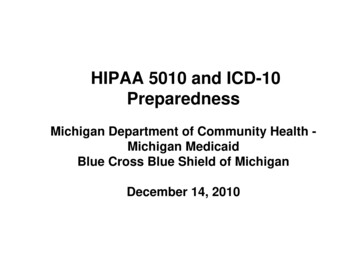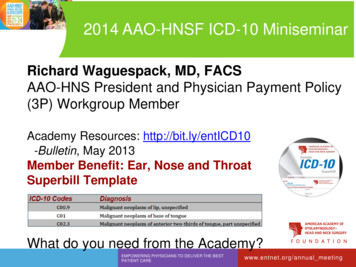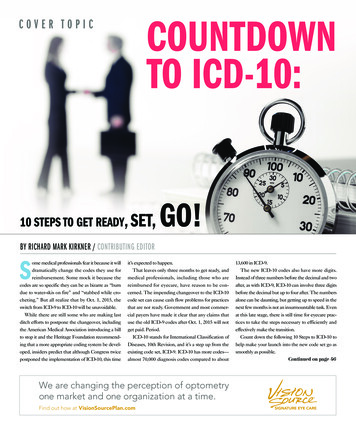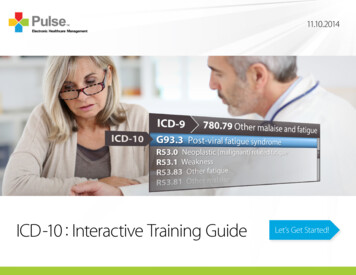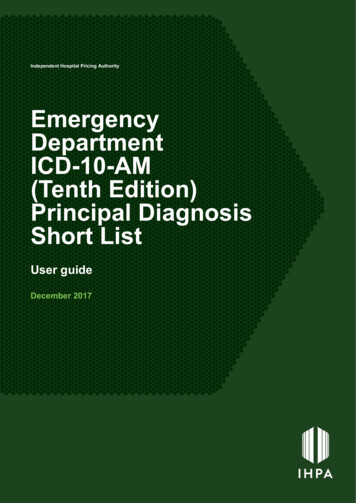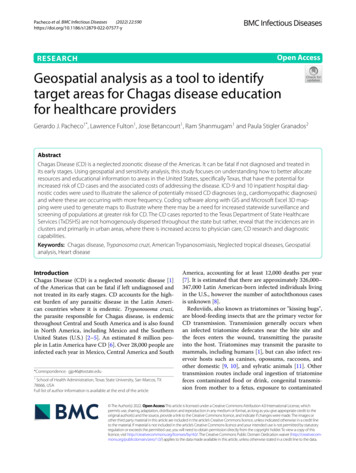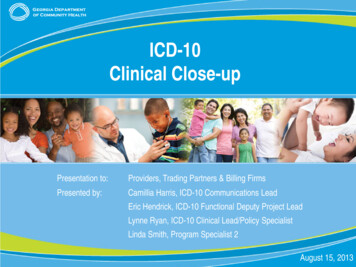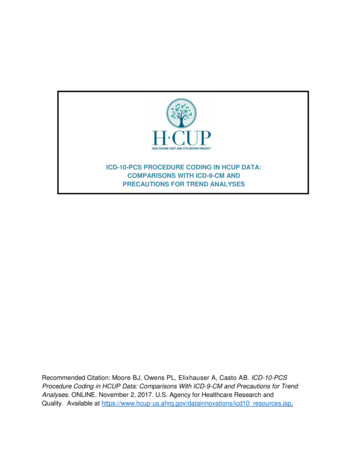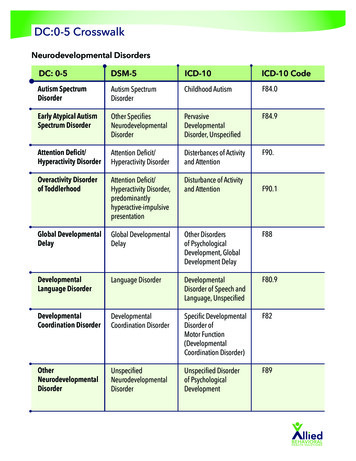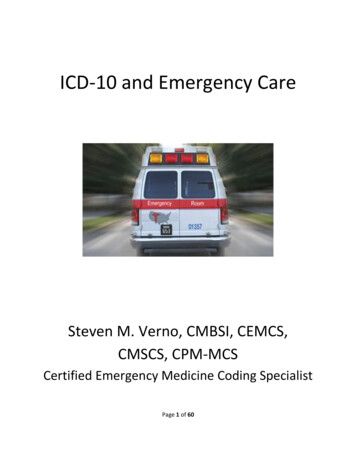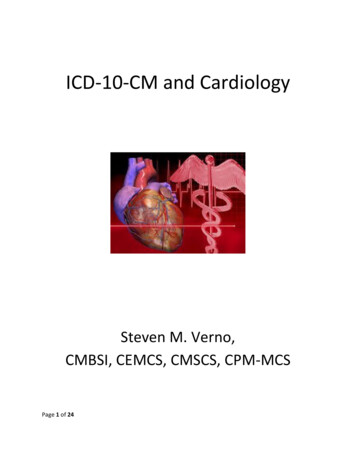
Transcription
ICD-10-CM and CardiologySteven M. Verno,CMBSI, CEMCS, CMSCS, CPM-MCSPage 1 of 24
ICD-10 and CardiologySteven M. Verno, CMBSI, CEMCS, CMSCS, CPM-MCSNote: ICD-9-CM and ICD-10 are owned and copyrighted by the World Health Organization. The codes inthis guide were obtained from the US Department of Health and Human Services, NCHS website. This guide does not contain ANY legal advice. This guide shows what specific codes will change to when ICD-9-CM becomes ICD-10-CM. This guide does NOT discuss ICD-10-PCS. This guide does NOT replace ICD-10-CM coding manuals. This guide simply shows a practice what ICD-10-CM will look like within their specialty. The intent is to show that ICD-10 is not scary and it is not complicated. This guide is NOT the final answer to coding issues experienced in a medical practice. This guide does NOT replace proper coding training required by a medical coder and a medicalpractice. Images or graphics were obtained from free public domain internet websites and may holdcopyright privileges by the owner.This guide was prepared for Free.If you paid for this, demand the return of your money!If the name of the original author, Steve Verno, has been replaced, it is possible that you have a thief onyour hands.Page 2 of 24
For the past thirty-one (31) years, we have learned and used ICD-9-CM when diagnosis coding for ourthproviders. ICD stands for International Classification of Diseases. We’ve been using the 9 Revision tothcode a documented medical condition and in October 2014 we will be replacing the 9 Revision with theth10 revision. As someone once said, just when we learned the answers, they changed the questions.Also, for years, there has been rumor that ICD-10 would be replacing ICD-9, and now this will soon be areality.ICD-10 will replace ICD-9-CM as of October 1, 2014.There is a new rumor that ICD-10 will be bypassed with ICD-11. The problem with thisnew rumor is that there is nothing, in writing, about this rumor. The fact that ICD-10will be effective as of October 1, 2014 is published by the Centers for Medicare andMedicaid Services and the World Health Organization. Anytime someone tells yousomething, GET IT IN WRITING! Rumors can ruin a practice and can cost a practice alot of money because you trust the person who told you the rumor and you want tobelieve it, so you or you have your staff search the internet for anything that providesprovenance to the rumor.In coding, there is a saying, “If it isn’t documented, it doesn’t exist.” If an employee ora doctor told you something, make sure that they provide you with documentation toback it up. How do I know this? My boss went to a conference and during a break,heard people talking about something. One of the speakers even said the same thing.When my boss came back, he had me stop my work and find out if what he heard wastrue. After a week of searching, I went back to my boss and told him that what heheard didn’t exist. His reply was, “I don’t believe you.” I am a speaker at conferences.Anything I present has laws, rules, or policies provided to show that what I’m saying istrue, accurate, and correct.I personally attended a conference where I heard a speaker say something that didn’tsound right. I wasn’t the only one because many hands went up. The speaker hadmany respected certifications, yet the speaker failed to provide any proof to hisstatement. When I asked for his documentation, he smiled and said I’ll send it to you.It’s been 10 years and nothing has come forth. All this did was lower my respect forthis person and I now question everything this person provides. I refuse to attend anyconference where he still speaks. My boss was correct with saying he didn’t believeme, but he learned a hard lesson. He spent about 1,000 in payroll to have me findanything that backed up what he heard at a conference. In the end, he dismissed whathe heard and from that point on, when we brought anything to him, we had to providePage 3 of 24
documented proof. That made me a better researcher. To provide proof to ICD-10being effective on October 1, 2014, can be found x.htmlOctober 1, 2014 is on a Wednesday. What this means is, on Tuesday, September 30,2014, you will use ICD-9-CM. At the end of the day, put your ICD-9 manuals in a safeplace because you may need them later on and I will explain this. When you come inthe next morning, you will open the brand new ICD-10-CM manuals and code the visitusing them.One huge change with ICD-10-CM is that there will be more codes to select from. ICD9 has about 14,000 codes. ICD-10 starts with 68,000 codes and can go higher. ICD-9did not have a code for a cranialrectal blockage, so you couldn’t code that diagnosis oryou had to select an unspecified code, but now you can have a code for a cranialrectalblockage (YOU do know that cranialrectal blockage is not a real disease or injury). ICD10 is going to change the way YOU do business. Why? It is 100% dependent onmedical record documentation. ICD-9 was forgiving to a doctor who is lax on theirdocumentation. Steve could visit Dr. Smith with pain in his right ear. All Dr. Smith hadto document was that Steve has OM which is short for otitis media and the coder couldselect a code for simple OM.That code is 382.9 - Unspecified otitis media, Otitis media: NOS, acute NOS, chronicNOSICD-10 will require more work on the provider to document the exact type ofdiagnosis found with the patient. ICD-10 demands documentation of theanatomical area affected and allows for coding of chronic modalities.Under ICD-10-CM, you have the following codes for Otitis Media:H66.9 Otitis media, unspecifiedH66.90 Otitis media, unspecified, unspecified earH66.91 Otitis media, unspecified, right earH66.92 Otitis media, unspecified, left earH66.93 Otitis media, unspecified, bilateralPage 4 of 24
As you can see, under ICD-9-CM, you have one code you can select if thedocumentation is not specific. The patient may have been a child with ear pain in bothears, but all the doctor wrote is “OM” and nothing more. Under ICD-10-CM, you have apossibility of five (5) codes and you do need more anatomical information to select thebest possible code. Using a pure unspecified code such as H66.9 could cause yourclaim to be pended or placed under review, which could cause a significant revenue lossfor the practice.A favorite doctor I’ve known for many years is an expert witness where he is called todetermine if a malpractice lawsuit should proceed to court or if the malpracticeinsurance company should issue a check. In many cases after looking at the medicalrecord, he recommends writing a check. He provides instruction to medical interns andresidents and he tells them: “Document the visit as if you had to appear in court todefend your actions. “ I usually add, “Document the visit as if your paycheck and careeris on the line.” I spend a lot of my time returning medical records for additionalinformation because the documentation is insufficient to code the visit with 100% truth,accuracy and correctness. I code to protect the doctor, the patient, and MY paycheck.I only code what is documented. I never code a visit just to get paid. There will be anunofficial rule with coding and that rule will be: If it isn’t documented, we don’t code it.We do NOT code something just to get it paid.With 30 years of clinical medicine in my personal background, I can say I know whatshould have been done during the visit, but I cannot code based on that. I’ve seendoctors tell me, “I did this procedure.” I say show me where it says you did this.There is no documentation to prove that the doctor said they did what they say and thedoctor loses. I also NEVER code based on what I am told on the internet. I don’t knowif what I’m told is 100% true, accurate and complete. I don’t know if the person askingthe question works for a doctor or if they are a coding student and I NEVER helpstudents. If I provide them with answers, they submit my work as their own and INEVER support fraud, including academic fraud, in any form. If I do a coders work forthem, they will never learn to become self-sufficient.Let’s say you have an untrained coder who needs to code a cranialrectalectomy. Theywill go to the internet and ask, I forgot what the code is for a cranialrectalectomy, “Cansomeone help me?” When they don’t get a response, they become angry and thenthey will post, “Can’t anyone here help me out?” They do this hoping someone will feelguilty and give them what they want. Someone may come along with a name ofToddCPC and say we use code 99999. ToddCPC is NOT a coder. ToddCPC is a schoolPage 5 of 24
kid in Omaha, Nebraska having fun punking the poster. So, now the coder enters99999 as the code and sends the claim to the insurance company. The claim is deniedpayment. Claim after claim is denied payment because this coder is sending claimswith bad codes. The doctor begins to notice the volume of denials and notices a hugedrop in his practice revenue, so he contacts a consultant. In addition, the insurancecompany put a halt on all claims sent by the doctor. They send a letter demandingmedical records and they’re now going back 20 years. The information on the claim iswrong and it is not documented in the medical record. The next letter the doctorreceives is a demand for the return of claim payments and they are demanding a 6figure refund. The doctor can’t fight this because the claim was sent with wrong codes,codes that are not supported by the medical record documentation.I recently went to a doctor who received a letter demanding the return of 64,000.That would cause him to go out of business. I showed how his coder was sendingclaim with wrong codes and that the medical record documentation was so poor, thatthey didn’t support any correct code that was submitted. Again, DOCUMENT THEMEDICAL RECORD AS IF YOU HAD TO GO TO COURT!Coding GuidelinesMany of the guidelines under ICD-9-CM will not change under ICD-10-CM.You will see new guidelines because ICD-10 will offer new codes never seenbefore. As an example:ICD-9 Guideline for Symptoms:Signs and symptomsCodes that describe symptoms and signs, as opposed to diagnoses, are acceptable forreporting purposes when a related definitive diagnosis has not been established(confirmed) by the physician. Chapter 16 of ICD-9-CM, Symptoms, Signs, and Illdefined conditions (codes 780.0 -799.9) contain many, but not all codes for symptoms.7. Conditions that are an integral part of a disease processSigns and symptoms that are integral to the disease process should not be assigned asadditional codes.8. Conditions that are not an integral part of a disease processAdditional signs and symptoms that may not be associated routinely with a diseaseprocess should be coded when present.Page 6 of 24
ICD-10 Guideline for Symptoms:Signs and symptomsCodes that describe symptoms and signs, as opposed to diagnoses, are acceptable forreporting purposes when a related definitive diagnosis has not been established(confirmed) by the provider. Chapter 18 of ICD-10-CM, Symptoms, Signs, and AbnormalClinical and Laboratory Findings, Not Elsewhere Classified (codes R00.0 - R99) containsmany, but not all codes for symptoms.5. Conditions that are an integral part of a disease processSigns and symptoms that are associated routinely with a disease process should not beassigned as additional codes, unless otherwise instructed by the classification.6. Conditions that are not an integral part of a disease processAdditional signs and symptoms that may not be associated routinely with a diseaseprocess should be coded when present.As you can see, both guidelines are virtually identical, so the change to ICD10 won’t be a shock to a trained coder.The ICD-10 coding guidelines related to cardiology are as follows:Hypertensive Heart and Chronic Kidney DiseaseAssign codes from combination category I13, Hypertensive heart and chronic kidneydisease, when both hypertensive kidney disease and hypertensive heart disease arestated in the diagnosis. Assume a relationship between the hypertension and thechronic kidney disease, whether or not the condition is so designated. If heart failure ispresent, assign an additional code from category I50 to identify the type of heartfailure.Hypertensive Cerebrovascular DiseaseFor hypertensive cerebrovascular disease, first assign the appropriate code fromcategories I60-I69, followed by the appropriate hypertension code.Hypertensive RetinopathyCode H35.0, Hypertensive retinopathy, should be used with code I10, Essential(primary) hypertension, to include the systemic hypertension. The sequencing is basedon the reason for the encounter.Page 7 of 24
Hypertension, SecondarySecondary hypertension is due to an underlying condition. Two codes are required: oneto identify the underlying etiology and one from category I15 to identify thehypertension. Sequencing of codes is determined by the reason foradmission/encounter.Hypertension, TransientAssign code R03.0, Elevated blood pressure reading without diagnosis of hypertension,unless patient has an established diagnosis of hypertension. Assign code O13.-,Gestational [pregnancy-induced] hypertension without significant proteinuria, or O14.-,Gestational [pregnancy-induced] hypertension with significant proteinuria, for transienthypertension of pregnancyHypertension, ControlledThis diagnostic statement usually refers to an existing state of hypertension undercontrol by therapy. Assign code I10.Hypertension, UncontrolledUncontrolled hypertension may refer to untreated hypertension or hypertension notresponding to current therapeutic regimen. In either case, assign code I10.Atherosclerotic coronary artery disease and anginaICD-10-CM has combination codes for atherosclerotic heart disease with anginapectoris. The subcategories for these codes are I25.11, Atherosclerotic heart disease ofnative coronary artery with angina pectoris and I25.7, Atherosclerosis of coronary arterybypass graft(s) and coronary artery of transplanted heart with angina pectoris.When using one of these combination codes it is not necessary to use an additionalcode for angina pectoris. A causal relationship can be assumed in a patient with bothatherosclerosis and angina pectoris, unless the documentation indicates the angina isdue to something other than the atherosclerosis.If a patient with coronary artery disease is admitted due to an acute myocardialinfarction (AMI), the AMI should be sequenced before the coronary artery disease.See Section I.C.9. Acute myocardial infarction (AMI)Sequelae of Cerebrovascular DiseaseCategory I69, Sequelae of Cerebrovascular diseaseCategory I69 is used to indicate conditions classifiable to categories I60-I67 as thecauses of late effects (neurologic deficits), themselves classified elsewhere. These “lateeffects” include neurologic deficits that persist after initial onset of conditionsclassifiable to categories I60-I67. The neurologic deficits caused by cerebrovascularPage 8 of 24
disease may be present from the onset or may arise at any time after the onset of thecondition classifiable to categories I60-I67.Codes from category I69 with codes from I60-I67Codes from category I69 may be assigned on a health care record with codes from I60I67, if the patient has a current cerebrovascular accident (CVA) and deficits from an oldCVA.Code Z86.73Assign code Z86.73, Personal history of transient ischemic attack (TIA), and cerebralinfarction without residual deficits (and not a code from category I69) as an additionalcode for history of cerebrovascular disease when no neurologic deficits are present.Acute myocardial infarction (AMI) ST elevation myocardial infarction (STEMI)and non ST elevation myocardial infarction (NSTEMI)The ICD-10-CM codes for acute myocardial infarction (AMI) identify the site, such asanterolateral wall or true posterior wall. Subcategories I21.0-I21.2 and code I21.4 areused for ST elevation myocardial infarction (STEMI). Code I21.4, Non-ST elevation(NSTEMI) myocardial infarction, is used for non ST elevation myocardial infarction(NSTEMI) and nontransmural MIs.Acute myocardial infarction, unspecifiedCode I21.3, ST elevation (STEMI) myocardial infarction of unspecified site, is the defaultfor the unspecified term acute myocardial infarction. If only STEMI or transmural MIwithout the site is documented, query the provider as to the site, or assign code I21.3.AMI documented as nontransmural or subendocardial but site providedIf an AMI is documented as nontransmural or subendocardial, but the site is provided, itis still coded as a subendocardial AMI. If NSTEMI evolves to STEMI, assign the STEMIcode. If STEMI converts to NSTEMI due to thrombolytic therapy, it is still coded asSTEMI.See Section I.C.21.3 for information on coding status post administration oftPA in a different facility within the last 24 hours.Subsequent acute myocardial infarctionA code from category I22, Subsequent ST elevation (STEMI) and non ST elevation(NSTEMI) myocardial infarction, is to be used when a patient who has suffered an AMIhas a new AMI within the 4 week time frame of the initial AMI. A code from categoryI22 must be used in conjunction with a code from category I21.The sequencing of the I22 and I21 codes depends on the circumstances of theencounter. Should a patient who is in the hospital due to an AMI have a subsequentPage 9 of 24
AMI while still in the hospital code I21 would be sequenced first as the reason foradmission, with code I22 sequenced as a secondary code. Should a patient have asubsequent AMI after discharge for care of an initial AMI, and the reason for admissionis the subsequent AMI, the I22 code should be sequenced first followed by the I21. AnI21 code must accompany an I22 code to identify the site of the initial AMI, and toindicate that the patient is still within the 4 week time frame of healing from the initialAMI. The guidelines for assigning the correct I22 code are the same as for the initialAMI.Anytime you have a question regarding coding, you must OPEN the manual and READthe guidelines. The problem most people have when they ask questions about codingcan be found in the manual. Again RTFM READ THE FREAKING MANUAL!I’ve been to practices where the coding manuals, usually 5 years old, are still in theirunopened packages. A good coder has the worst looking coding manual where thepages are worn, dog-eared, ink filled with personal notes, has pages containing yellowpost it notes, and almost falling apart. Most important, NEVER listen to the officewannabe! RTFM!Cardiology CodesLet’s look at some of the most used codes in some Cardiology practices. Pleaseunderstand that this guide does NOT contain all codes used. This guide does not takethe place of coding or published coding manuals. These codes may change in October2014. They are current as of the day this guide was prepared. If additionalinformation is needed to obtain a more accurate code, it will be noted. Some ICD-9-CMcodes do NOT convert easily to ICD-10-CM. The medical record documentation willneed to be more specific.ICD-9 codes are 3, 4, or 5 numbers with E or V codes being a letter and a set ofnumbers, up to 5 digits. ICD-10 is a letter and numbers. It can go up to 7 digits.Code I06.8 is not one zero six point eight. It is letter eye(I) zero six point eight. V70.0is an ICD-9 code, not an ICD-10 code.NUMERICAL ORDER BY ICD-9-CMICD-9-CM395.9 - Other and unspecified rheumatic aortic diseasesICD-10-CMI06.8 - Other rheumatic aortic valve diseasesPage 10 of 24
ICD-9-CM396.9 - Mitral and aortic valve diseases, unspecifiedICD-10-CMToo many codes to list, requires more specific documentation andinformationICD-9-CM401.1 - Benign essential hypertensionICD-10-CMI10 - Essential (primary) hypertensionICD-9-CM414.01 Coronary atherosclerosis of native coronary arteryICD-10-CMI25.110 - Atherosclerotic heart disease of native coronary artery withunstable angina pectorisI25.111 - Atherosclerotic heart disease of native coronary artery with anginapectoris with documented spasmI25.118 - Atherosclerotic heart disease of native coronary artery with otherforms of angina pectorisI25.119 - Atherosclerotic heart disease of native coronary artery withunspecified angina pectorisICD-9-CM427.31 - Atrial fibrillationICD-10-CMToo many codes to list, requires additional information to obtain a specificand accurate code.ICD-9-CM428.0 - Congestive heart failure, unspecifiedICD-10-CMI50.20 - Unspecified systolic (congestive) heart failureI50.30 - Unspecified diastolic (congestive) heart failureICD-9-CM444.09 - Other arterial embolism and thrombosis of abdominal aortaICD-10-CMI74.09 - Other arterial embolism and thrombosis of abdominal aortaICD-9-CM440.21 - Atherosclerosis of native arteries of the extremities with intermittentclaudicationICD-10-CMI70.25 - Atherosclerosis of native arteries of other extremities withulcerationPage 11 of 24
ICD-9-CM451.83 - Phlebitis and thrombophlebitis of deep veins of upper extremitiesICD-10-CMI82.721 - Chronic embolism and thrombosis of deep veins of right upper extremityMore anatomical reference to specific blood vessels are needed to obtain amore better code.ICD-9-CM414.01 Coronary atherosclerosis; of native coronary arteryICD-10-CMNeeds more informationI25.1 Atherosclerotic heart disease of native coronary arteryI25.10 Atherosclerotic heart disease of native coronary artery withoutangina pectorisI25.11 Atherosclerotic heart disease of native coronary artery with anginapectorisI25.110 Atherosclerotic heart disease of native coronary artery withunstable angina pectorisI25.111 Atherosclerotic heart disease of native coronary artery with anginapectoris with documented spasmI25.118 Atherosclerotic heart disease of native coronary artery with otherforms of angina pectorisI25.119 Atherosclerotic heart disease of native coronary artery withunspecified angina pectorisICD-9-CM414.9 Chronic ischemic heart disease, unspecifiedICD-10-CMI25.9 Chronic ischemic heart disease, unspecifiedICD-9-CM996.0 (ICD-9-CM Code does not exist) (This was a code provided to me by acardiology practice as one of their top 10 codes they use with patient visits.)The process for coding ICD-10 is no different than that of ICD-9, but documentation willbe the success or failure of ICD-10. Improper or lack of documentation will only delayclaims processing and will decrease practice revenue. The coder reads the medicalPage 12 of 24Pain(s) (see also Painful) R52 - chest (central) R07.4 - - anterior wall R07.89
record. The coder reads that the doctor documented “Chest pain”. The coder opensthe ICD-10 manual, goes to the Index (words) and looks up the condition, which in thiscase is Pain.As you can see from the above ICD-10 index, you have chest pain listed as R07.4. Nextyou want to go to the tabular section to make sure that R07.4 is the correct code andto see if there are any coding conventions. Coding conventions provide us withadditional information we need to ensure we have the correct code. The tabular forR07 is on the next page. R07 Pain in throat and chestExcludes.:dysphagia (R13) epidemic myalgia (B33.0) pain in:breast (N64.4)neck (M54.2)sore throat (acute) NOS (J02.9)R07.0 Pain in throatR07.1 Chest pain on breathingIncl.:Painful respirationR07.2 Precordial painR07.3 Other chest painIncl.:Anterior chest-wall pain NOSR07.4 Chest pain, unspecifiedIf you look at the above tabular section, you can see coding conventions identical tothose from ICD-9-CM. You can see NOS which means Not Otherwise Specified, Inclwhich means Includes and excludes which means these medical conditions are notincluded in this code. Code R07.4 has no coding conventions or additional information,so, based on the medical record documentation of chest pain, we can select R07.4.Again, if you can code ICD-9, you can code ICD-10. If you don’t have the training inthe process of coding, you won’t be able to code under ICD-10.CODING CHAPTERSPage 13 of 24
Under ICD-9-CM, you have the following:Chapter 1: Infectious and Parasitic Diseases (001-139)Chapter 2: Neoplasms (140-239)Chapter 3: Endocrine, Nutritional, and Metabolic Diseases and ImmunityDisorders (240-279)Chapter 4: Diseases of Blood and Blood Forming Organs (280-289)Chapter 5: Mental Disorders (290-319)Chapter 6: Diseases of Nervous System and Sense Organs (320-389)Chapter 7: Diseases of Circulatory System (390-459)Chapter 8: Diseases of Respiratory System (460-519)Chapter 9: Diseases of Digestive System (520-57Chapter 10: Diseases of Genitourinary System (580-629)Chapter 11: Complications of Pregnancy, Childbirth, and the Puerperium (630677)Chapter 12: Diseases Skin and Subcutaneous Tissue (680-709)Chapter 13: Diseases of Musculoskeletal and Connective Tissue (710-739)Chapter 14: Congenital Anomalies (740-759)Chapter 15: Newborn (Perinatal) Guidelines (760-779)Chapter 16: Signs, Symptoms and Ill-Defined Conditions (780-799)Chapter 17: Injury and Poisoning (800-999)Chapter 18: Classification of Factors Influencing Health Status and Contact withHealth Service (Supplemental V01-V84) andSupplemental Classification of External Causes of Injury and Poisoning (E-codes,E800-E999)Under ICD-10, you have the following:Chapter 1: Certain infectious and parasitic diseases (A00-B99)Chapter 2: Neoplasms (C00-D48)Chapter 3: Diseases of the blood and blood-forming organs and certain disordersinvolving the immune mechanism (D50-D89)Chapter 4: Endocrine, nutritional and metabolic diseases (E00-E90)Chapter 5: Mental and behavioral disorders (F01-F99)Chapter 6: Diseases of the nervous system (G00-G99)Chapter 7: Diseases of the eye and adnexa (H00-H59)Chapter 8: Diseases of the ear and mastoid process (H60-H95)Chapter 9: Diseases of the circulatory system (I00-I99)Chapter 10: Acute upper respiratory infections (J00-J06)Chapter 11: Diseases of oral cavity and salivary glands (K00-K14)Chapter 12: Diseases of the skin and subcutaneous tissue (L00-L99)Chapter 13: Diseases of the musculoskeletal system and connective tissue (M00M99)Page 14 of 24
Chapter 14: Diseases of the genitourinary system (N00-N99)Chapter 15: Pregnancy, childbirth and the puerperium (O00-O99)Chapter 16: Certain conditions originating in the perinatal period (P00-P96)Chapter 17: Congenital malformations, deformations and chromosomalabnormalities (Q00-Q99)Chapter 18: Symptoms and signs involving the circulatory and respiratorysystems (R00-R09)Chapter 19: Injury, poisoning and certain other consequences of external causes(S00-T98)Chapter 20: External causes of morbidity (V01-Y98)Factors influencing health status and contact with health services (Z00-Z99)E Codes will become V-Y CodesV Codes will become Z Codes.The Table of Drugs and Biologicals that were 900 series codes and E Codes are now TCodes.There were 18 Chapters in ICD-9-CM and we have 20 chapters under ICD-10-CM.The proposed effective date for ICD-10 is October 1, 2014.So, what do we have to do?PREPARING FOR ICD-10TrainingIf your current coder has NO training, you need to send them to be trained how tocode. If they cannot code under ICD-9, they will not be able to code under ICD-10. AsI stated the process of coding is the same. Being the spouse of the doctor, areceptionist or an accountant is NOT a coder.A coder MUST read the medical record, go to the coding manual and find the code inthe Index, then go to the tabular and read the actual code. The coder must read anycoding conventions to determine the exact code that is documented in the medicalrecord. Coding is NOT getting a test study guide and taking that test to be awardedinitials. What happens is that the person comes along and asks for codes using theinternet. It’s sad when you see someone with reputable coding initials asking basicquestions, “Can someone give me a code for chest pain?” or “What code can I use witha cranialrectalectomy?” The code being provided may be fake and the person askingwill have no clue to this because they don’t know how to code and they won’t open themanual. Forums will stop providing codes to those who ask. Right now, some arePage 15 of 24
telling the person asking for a code that the forum is not the proper place to ask forcodes. The student who cheats by asking a forum to provide them with the codinganswers to their homework or their test will find themselves expelled and if hired, willbecome unemployed.At one time, I was teaching a coding class. I gave my students a homeworkassignment. One of my students asked every question, hoping to get someone to doher work. Someone gave her all incorrect answers. When she turned in herhomework, the class was given a pop quiz. The pop quiz was the homeworkassignment. She made a copy of her homework and tried to hide the pages in hercoding manual. Instead of looking up the codes, she was copying the answers from herhomework. She was very surprised that she failed every test answer. What was alsointeresting is that a couple of my other students did the same thing by going on theinternet to get someone to answer their homework assignment. It was interesting thatthe student had every homework question correct, yet, they failed the same identicalquestion when tested on those questions.Years ago, I was taught RTFM! When I asked a fellow coder a question, his reply wasRTFM! Over and over I was told RTFM! What’s RTFM? READ THE FREAKINGMANUAL, only freaking is a nice way of saying the “F” word. They were right. I musthave read thousands of medical records during my training and my coding book was soworn out. I learned: Read the medical record, look up the condition in the index, lookup the code in the tabular, pay attention to coding conventions. I spent 6 months on aprobationary status before being allowed to code an actual visit for claim submission.My teacher made sure I was 100% accurate, 100% of the time. In a company where Iworked, we had a coder with a mile of initials come to me, asking, “Steve
ICD-10 will replace ICD-9-CM as of October 1, 2014. There is a new rumor that ICD-10 will be bypassed with ICD-11. The problem with this . you will open the brand new ICD-10-CM manuals and code the visit using them. One huge change with ICD-10-CM is that there will be more codes to select from. ICD-
